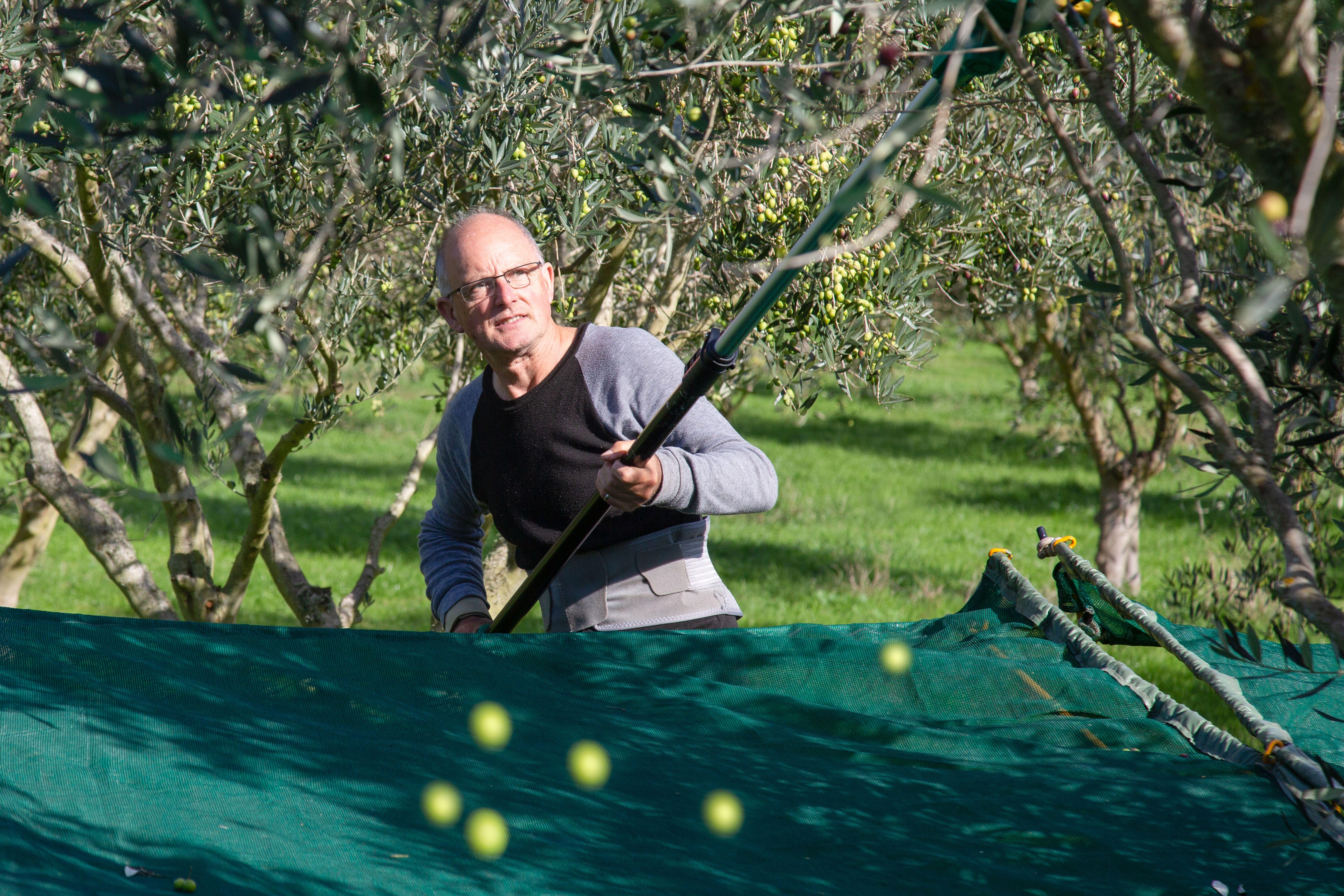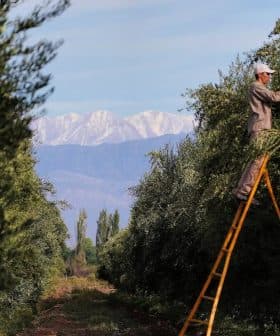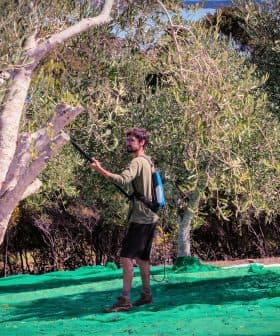Extreme Weather Batters NZ Growers, Causing Second-Consecutive Production Decline

New Zealand’s olive harvest has concluded with a decrease in yield and volume due to frost, heavy rainfall, and anthracnose. Growers reported smaller fruit and challenges in harvesting, with some regions faring better than others in terms of production. Despite the difficult year, producers are looking forward to the next harvest with hopes of improved conditions.
New Zealand’s olive harvest is drawing to a close, and as anticipated, the country’s olive oil producers have reported a decline in yield and volume.
Frost before harvest time, heavy rainfall and anthracnose have driven the fall in production.
With the onset of El Niño, we’re hoping for a lift in production, oil yield and polyphenols in 2024. Like the noble fruit, it is best to be humble about 2023 and hopeful for 2024.
“All in all, yield and volume is down this year for most growers, with fruit being smaller than normal or full of water,” Emma Glover, Olives New Zealand’s executive officer, told Olive Oil Times.
This aligned with what she had predicted earlier this year. Olives New Zealand will know the estimated total yield in September.
See Also:2023 Harvest Updates“The oils produced are generally milder and more delicate than the usual robust New Zealand flavors,” Glover said.
Many New Zealand olive growers told her that the 2023 harvest had been challenging.
“Late frosts combined with a wet and windy spring saw the year start with fruit set lower across many regions,” Glover said.
“The South Island had a decent summer, with the Tasman-Nelson region gunning for the 2023 best-producing area for both volume and yield,” she added. “Unfortunately, other regions had fruit damaged with early frosts before harvest.”
“For the North Island, summer was non-existent; even without Cyclone Gabrielle, sunshine hours were well down, and rainfall was up,” Glover continued. “Access to the wet groves has been difficult, causing lapses in grove management programs, resulting in anthracnose now being prevalent throughout North Island groves.”
She said some producers tried to harvest earlier to salvage all the possible fruit, and some small growers did not bother to harvest.
“A late window of fine weather has helped some that are harvesting later,” Glover said. “However, it is reported olive varieties are ripening out of their usual sequence, and some groves have now got flowers.”
“Birds have been a real nuisance country-wide,” she added. “Sparrows are a nuisance, but starlings are our main problem as they fly around in massive flocks.”
Andrew Liley, the co-owner of Juno Olives from the Wairarapa region on the North Island, said they started harvesting in mid-June, slightly later than planned and wrapped up early in July.
He said that even with their fruit volume up significantly from the previous year, their oil yield was down, pushing up their cost per liter almost 50 percent higher than last year.
“We had a lot of fruit this year,” he said. “It was an on-year for us, but significantly greater weight of fruit than previous on-years.”
“Unfortunately, the yield of oil was much lower than previous years, varying from only 7 to 11 percent,” Liley added.
Earlier this year, Liley told Olive Oil Times that he was unsure if ripening would be later or if they would harvest predominantly green fruit. It turned out to be the latter.
“Our Koroneiki was harvested very green as it showed no sign of ripening, and it was starting to be taken by birds,” Liley said. “Other varieties matured later than usual, and we were concerned about frosts in the last week or so of our harvest this year.”
“The wet weather we have had all year made access to the grove for the harvesting machinery difficult, which is very unusual for our grove,” he added. “The main things for us this year were the weather, sunlight hours down by 290 in the year and significantly more rain.”
However, Liley said the development of El Niño likely indicated that the country would face dry weather in the next harvest and “be wishing for rain later in the year.”
Meanwhile, the co-owner of Kapiti Olives on the Kāpiti Coast north of Wellington, Diana Crosse, also reported a drop in yield.

Diana Crosse and her husband, Grant
She told Olive Oil Times that they harvested their Leccino and Picual at the end of May and their Frantoio and Koroneiki 10 days later.
“I believe we harvested too early, mainly due to our inexperience, as there seemed to be a lot of olives not shaken off,” Crosse said. “So far, we have had a good winter. Much better than our summer and autumn.”
“Our harvest is down this year, about 25 percent,” she added. “This is due to a very heavy prune (our trees are getting too big), pollination interruption, the poor summer and our inexperience as new owners with critical spray times.”
“We also suffered from anthracnose with the weather we have had,” Crosse continued. “Interestingly, some of our trees have flowers on them, much too early. But we have oil for our markets and are looking positively forward to the new season.”
Another producer from the North Island, Blue Earth, started harvesting in mid-June, as they were expecting to.
“We also went later than we have ever done before,” the co-owner Margaret Hanson told Olive Oil Times. “Some fruit took longer to ripen given the wet autumn and early winter and because we had such a large crop on the trees.”
“We were very happy,” she added. “The yields were low, particularly in our Barnea and Manzanillo, but made up for with a very big crop, many trees with over 35 kilograms. Last year was good for us as well. But this was larger.”
Hanson said they had issues as a result of heavy rainfall this year.
“We are on an old river terrace, which is usually very dry and firm, even in winter. With this year’s rainfall, the surface became soft,” she said. “It doesn’t look pretty, but it didn’t impact the crop, as much was done by machine harvest.”

Ross Vintiner
Meanwhile, Ross Vintiner, co-owner of Vintiner’s Grove, said La Niña weather conditions dominated this year’s harvest.
“As expected, the Tuscan varieties – Leccino and Frantoio – handled the wettest year we’ve experienced in a decade,” he said. “The Spanish and Greek varieties suffered in both quantity and quality. Overall, oil yields were down on previous years, again a result of the extremely wet conditions.”
“Abnormally wet and sunless conditions meant lower polyphenol levels, as predicted,” Vintiner added. “From feedback on oil certification results, a similar result has been experienced across much of Aotearoa/New Zealand.”
“A seasoned grower of 21 harvests told me it was her worst year ever,” he concluded. “With the onset of El Niño, we’re hoping for a lift in production, oil yield and polyphenols in 2024. Like the noble fruit, it is best to be humble about 2023 and hopeful for 2024.”



